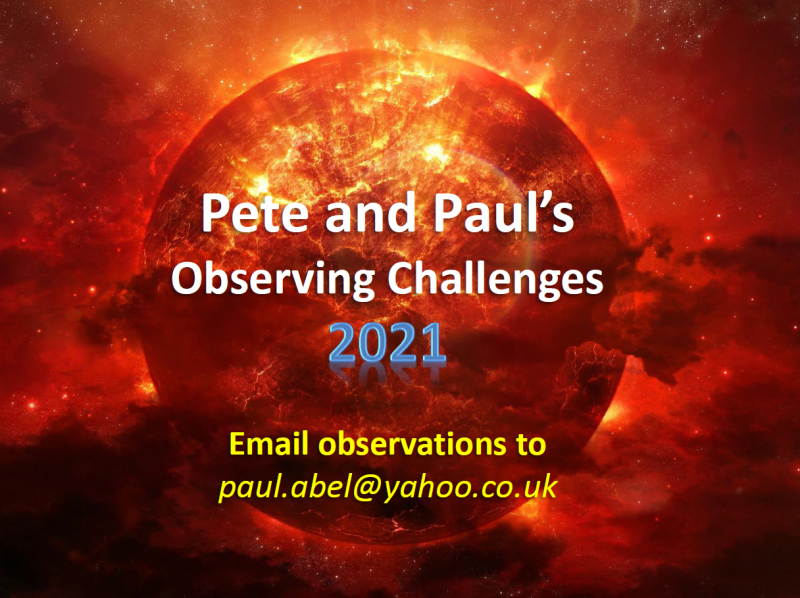2021 April 12
Pete and Paul’s Observing Challenges for 2021

Pete and Paul gave their popular presentation on Observing Challenges at the 2021 Winchester Webinar. Click here if you would like to view the full pdf of their presentation and you can watch the video on the BAA YouTube Channel.
List of Challenges
- Venus at dichotomy: finding the date when Venus appears to 50% illuminated in the telescope.
- The Saturn Moon Challenge: How many moons of Saturn can you see? How many can you capture in an image?
- The Moon Against the Spicule Layer: On 2021 June 10 there will be a partial eclipse of the sun. Just before first contact, and just after last contact, you should be able to see/photograph the moon against the spicule layer of the sun.
- A New Twist on M57’s Central Star: The Ring Nebula (or M57) in Lyra is a splendid planetary nebula- at its centre is the dead star whose outer atmosphere was blown into space creating the nebula. The challenge is to capture the central star using a Smartphone.
- The Moons of Uranus: The seventh planet from the Sun is well placed in UK skies and comes to opposition on 4th November 2021. This is a good time to look at the satellites of Uranus – how many can you spot?
- Thin Moon Hunting: Just before new moon, and immediately after new moon our satellite has a very small phase known as a ‘thin moon’. Catching them can be quite a challenge- Pete managed to get an image some 15h13m after new moon, can you beat that?
- The Rilles of Gassendi: Gassendi crater is a splendid impact crater on the moon. The floor of Gassendi crater is crossed by many rilles, some of them quite fine. How much of the rille system can you see?
- Smartphone NLCs: Soon we will see the return of Noctilucent Clouds- brilliant clouds very high up in the atmosphere. Displays of NLCs can be very bright, and they can be nicely imaged on a Smartphone, see if you can catch a display on your Smartphone this year!
- The Distance to Delta Cephei: Delta Cephei is the proto-type ‘Cepheid Variable’. The magnitude of these stars varies, and there is a well-established relationship between their period and their distance. Find the period and absolute magnitude to determine the distance to this star.
- Imaging a Galilean Satellite Eclipse: This year we will be passing through the equatorial plane of Jupiter. As a result, the four largest Galilean satellites: Io, Europa, Ganymede and Callisto will appear to undergo ‘mutual phenomena’ whereby they will seem to pass in front or behind each other (or their shadows). See if you can capture some of these!
Let Paul know how you get on by emailing him at paul.abel@yahoo.co.uk with your observations. You can also send them to the relevant Section Director who will be pleased to receive them, and you can upload them to your BAA Album on the website.
| The British Astronomical Association supports amateur astronomers around the UK and the rest of the world. Find out more about the BAA or join us. |
